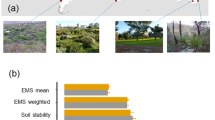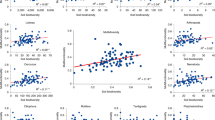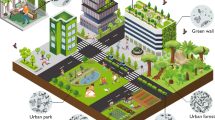Abstract
While the contribution of biodiversity to supporting multiple ecosystem functions is well established in natural ecosystems, the relationship of the above- and below-ground diversity with ecosystem multifunctionality remains virtually unknown in urban greenspaces. Here we conducted a standardized survey of urban greenspaces from 56 municipalities across six continents, aiming to investigate the relationships of plant and soil biodiversity (diversity of bacteria, fungi, protists and invertebrates, and metagenomics-based functional diversity) with 18 surrogates of ecosystem functions from nine ecosystem services. We found that soil biodiversity across biomes was significantly and positively correlated with multiple dimensions of ecosystem functions, and contributed to key ecosystem services such as microbially driven carbon pools, organic matter decomposition, plant productivity, nutrient cycling, water regulation, plant–soil mutualism, plant pathogen control and antibiotic resistance regulation. Plant diversity only indirectly influenced multifunctionality in urban greenspaces via changes in soil conditions that were associated with soil biodiversity. These findings were maintained after controlling for climate, spatial context, soil properties, vegetation and management practices. This study provides solid evidence that conserving soil biodiversity in urban greenspaces is key to supporting multiple dimensions of ecosystem functioning, which is critical for the sustainability of urban ecosystems and human wellbeing.
This is a preview of subscription content, access via your institution
Access options
Access Nature and 54 other Nature Portfolio journals
Get Nature+, our best-value online-access subscription
$29.99 / 30 days
cancel any time
Subscribe to this journal
Receive 12 digital issues and online access to articles
$119.00 per year
only $9.92 per issue
Buy this article
- Purchase on Springer Link
- Instant access to full article PDF
Prices may be subject to local taxes which are calculated during checkout






Similar content being viewed by others
Data availability
Soil biodiversity, plant diversity and ecosystem functioning data from urban greenspaces are publicly available at figshare: https://doi.org/10.6084/m9.figshare.21175492.v3 (ref. 64).
Code availability
Code for statistical analyses is available at https://github.com/huahuafan/Global-urban-greenspaces.
References
Griggs, D. et al. Sustainable development goals for people and planet. Nature 495, 305–307 (2013).
Charlop-Powers, Z. et al. Urban park soil microbiomes are a rich reservoir of natural product biosynthetic diversity. Proc. Natl Acad. Sci. USA 113, 14811 (2016).
Delgado-Baquerizo, M. et al. Global homogenization of the structure and function in the soil microbiome of urban greenspaces. Sci. Adv. 7, eabg5809 (2021).
Martínez, J. L. Antibiotics and antibiotic resistance genes in natural environments. Science 321, 365–367 (2008).
Forsberg, K. J. et al. The shared antibiotic resistome of soil bacteria and human pathogens. Science 337, 1107–1111 (2012).
Byrnes, J. E. K. et al. Investigating the relationship between biodiversity and ecosystem multifunctionality: challenges and solutions. Methods Ecol. Evolution 5, 111–124 (2014).
Gamfeldt, L. & Roger, F. Revisiting the biodiversity–ecosystem multifunctionality relationship. Nat. Ecol. Evolution 1, 0168 (2017).
Lefcheck, J. S. et al. Biodiversity enhances ecosystem multifunctionality across trophic levels and habitats. Nat. Commun. 6, 6936 (2015).
Zavaleta, E. S. et al. Sustaining multiple ecosystem functions in grassland communities requires higher biodiversity. Proc. Natl Acad. Sci. USA 107, 1443 (2010).
Delgado-Baquerizo, M. et al. Microbial diversity drives multifunctionality in terrestrial ecosystems. Nat. Commun. 7, 10541 (2016).
Wagg, C. et al. Soil biodiversity and soil community composition determine ecosystem multifunctionality. Proc. Natl Acad. Sci. USA 111, 5266 (2014).
van der Heijden, M. G. A. et al. Mycorrhizal fungal diversity determines plant biodiversity, ecosystem variability and productivity. Nature 396, 69–72 (1998).
Delgado-Baquerizo, M. et al. Multiple elements of soil biodiversity drive ecosystem functions across biomes. Nat. Ecol. Evol. 4, 210–220 (2020).
Ramirez, K. S. et al. Biogeographic patterns in below-ground diversity in New York City’s Central Park are similar to those observed globally. Proc. R. Soc. B 281, 20141988 (2014).
Schittko, C. et al. Biodiversity maintains soil multifunctionality and soil organic carbon in novel urban ecosystems. J. Ecol. https://doi.org/10.1111/1365-2745.13852 (2022).
Maestre, F. T. et al. Plant species richness and ecosystem multifunctionality in global drylands. Science 335, 214–218 (2012).
Jing, X. et al. The links between ecosystem multifunctionality and above-and belowground biodiversity are mediated by climate. Nat. Commun. 6, 1–8 (2015).
Kadowaki, K. et al. Mycorrhizal fungi mediate the direction and strength of plant–soil feedbacks differently between arbuscular mycorrhizal and ectomycorrhizal communities. Commun. Biol. 1, 196 (2018).
Soliveres, S. et al. Biodiversity at multiple trophic levels is needed for ecosystem multifunctionality. Nature 536, 456–459 (2016).
Berman, J. J. in Taxonomic Guide to Infectious Diseases (ed. Berman, J. J.) 37–47 (Academic Press, 2012).
Berman, J. J. in Taxonomic Guide to Infectious Diseases (ed. Berman, J. J.) 25–31 (Academic Press, 2012).
Busse, H.-J. in Methods in Microbiology (eds Rainey, F. & Oren. A.) Vol. 38, 239–259 (Academic Press, 2011).
van den Hoogen, J. et al. Soil nematode abundance and functional group composition at a global scale. Nature 572, 194–198 (2019).
van Bergeijk, D. A. et al. Ecology and genomics of Actinobacteria: new concepts for natural product discovery. Nat. Rev. Microbiol. 18, 546–558 (2020).
Orellana, L. H. et al. Verrucomicrobiota are specialist consumers of sulfated methyl pentoses during diatom blooms. ISME J. 16, 630–641 (2022).
Fincker, M. et al. Metabolic strategies of marine subseafloor Chloroflexi inferred from genome reconstructions. Environ. Microbiol. 22, 3188–3204 (2020).
Stralis-Pavese, N. et al. Analysis of methanotroph community composition using a pmoA-based microbial diagnostic microarray. Nat. Protoc. 6, 609–624 (2011).
Berube, P. M. et al. Physiology and evolution of nitrate acquisition in Prochlorococcus. ISME J. 9, 1195–1207 (2015).
Liang, J.-L. et al. Novel phosphate-solubilizing bacteria enhance soil phosphorus cycling following ecological restoration of land degraded by mining. ISME J. 14, 1600–1613 (2020).
Hättenschwiler, S. & Gasser, P. Soil animals alter plant litter diversity effects on decomposition. Proc. Natl Acad. Sci. USA 102, 1519 (2005).
Erktan, A. et al. The physical structure of soil: determinant and consequence of trophic interactions. Soil Biol. Biochem. 148, 107876 (2020).
Grime, J. P. Benefits of plant diversity to ecosystems: immediate, filter and founder effects. J. Ecol. 86, 902–910 (1998).
Barberán, A. et al. Why are some microbes more ubiquitous than others? Predicting the habitat breadth of soil bacteria. Ecol. Lett. 17, 794–802 (2014).
Chen, Q. L. et al. Rare microbial taxa as the major drivers of ecosystem multifunctionality in long-term fertilized soils. Soil Biol. Biochem. 141, 107686 (2020).
Zhang, Z. et al. Rare species-driven diversity-ecosystem multifunctionality relationships are promoted by stochastic community assembly. mBio. mBio. 13, e00449–22 (2022).
Domínguez-García, V. et al. Unveiling dimensions of stability in complex ecological networks. Proc. Natl Acad. Sci. USA 116, 25714 (2019).
Zhang, L. et al. Signal beyond nutrient, fructose, exuded by an arbuscular mycorrhizal fungus triggers phytate mineralization by a phosphate solubilizing bacterium. ISME J. 12, 2339–2351 (2018).
Couturier, M. et al. Lytic xylan oxidases from wood-decay fungi unlock biomass degradation. Nat. Chem. Biol. 14, 306–310 (2018).
Steinberg, G. et al. A lipophilic cation protects crops against fungal pathogens by multiple modes of action. Nat. Commun. 11, 1608 (2020).
Johnston, A. S. A. & Sibly, R. M. The influence of soil communities on the temperature sensitivity of soil respiration. Nat. Ecol. Evol. 2, 1597–1602 (2018).
Watson, C. J. et al. Ecological and economic benefits of low-intensity urban lawn management. J. Appl. Ecol. 57, 436–446 (2020).
Williams, N. S. G. et al. A conceptual framework for predicting the effects of urban environments on floras. J. Ecol. 97, 4–9 (2009).
Trabucco, A. & Zomer, R. Global Aridity Index and Potential Evapotranspiration (ET0) Climate Database v2 (figshare, 2019); https://doi.org/10.6084/m9.figshare.7504448.v3
Kettler, T. A. et al. Simplifed method for soil particle-size determination to accompany soil-quality analyses. Soil Sci. Soc. Am. J. 65, 849–852 (2001).
Delgado-Baquerizo, M. et al. Changes in belowground biodiversity during ecosystem development. Proc. Natl Acad. Sci. USA 116, 6891 (2019).
Ramirez, K. S. et al. Biogeographic patterns in below-ground diversity in New York City’s Central Park are similar to those observed globally. Proc. Biol. Sci. 281, 22 (2014).
Callahan, B. J. et al. DADA2: high-resolution sample inference from Illumina amplicon data. Nat. Methods 13, 581–583 (2016).
Tedersoo, L. et al. Regional-scale in-depth analysis of soil fungal diversity reveals strong pH and plant species effects in Northern Europe. Front. Microbiol. 11, 1953 (2020).
Bastida, F. et al. Microbiological degradation index of soils in a semiarid climate. Soil Biol. Biochem. 38, 3463–3473 (2006).
Lugato, E. et al. Different climate sensitivity of particulate and mineral-associated soil organic matter. Nat. Geosci. 14, 295–300 (2021).
Delgado-Baquerizo, M. et al. The influence of soil age on ecosystem structure and function across biomes. Nat. Commun. 11, 4721 (2020).
Frostegård, Å. et al. Use and misuse of PLFA measurements in soils. Soil Biol. Biochem. 43, 1621–1625 (2011).
Olsson, P. A. et al. The use of phospholipid and neutral lipid fatty acids to estimate biomass of arbuscular mycorrhizal fungi in soil. Mycol. Res. 99, 623–629 (1995).
Campbell, C. D. et al. A rapid microtiter plate method to measure carbon dioxide evolved from carbon substrate amendments so as to determine the physiological profiles of soil microbial communities by using whole soil. Appl. Environ. Microbiol. 69, 3593–3599 (2003).
Bell, C. W. et al. High-throughput fluorometric measurement of potential soil extracellular enzyme activities. J. Vis. Exp. 15, e50961 (2013).
Nguyen, N. H. et al. FUNGuild: an open annotation tool for parsing fungal community datasets by ecological guild. Fungal Ecol. 20, 241–248 (2016).
Fierer, N. et al. Cross-biome metagenomic analyses of soil microbial communities and their functional attributes. Proc. Natl Acad. Sci. USA 109, 21390–21395 (2012).
Fierer, N. et al. Reconstructing the microbial diversity and function of pre-agricultural tallgrass prairie soils in the United States. Science 342, 621–624 (2013).
Buchfink, B., Reuter, K. & Drost, H. G. Sensitive protein alignments at tree-of-life scale using DIAMOND. Nat. Methods 18, 366–368 (2021).
Manning, P. et al. Redefining ecosystem multifunctionality. Nat. Ecol. Evolution 2, 427–436 (2018).
Legendre, P. & Legendre, L. Interpretation of Ecological Structures Numerical Ecology 3rd English edn (Elsevier Science BV, 2012).
Grace, J. B. Structural Equation Modeling and Natural Systems (Cambridge University Press, 2006).
Subramanian, S. et al. Persistent gut microbiota immaturity in malnourished Bangladeshi children. Nature 510, 417 (2014).
Fan, K. et al. Soil biodiversity supports the delivery of multiple ecosystem functions in urban greenspaces. figshare https://doi.org/10.6084/m9.figshare.21175492.v3 (2022).
Acknowledgements
We thank the researchers involved in the MUSGONET project for collection of field data and soil samples. This study was supported by a 2019 Leonardo Grant for Researchers and Cultural Creators, BBVA Foundation (URBANFUN), and by the BES grant agreement number LRB17\1019 (MUSGONET). M.D.-B. acknowledges support from the Spanish Ministry of Science and Innovation for the I+D+i project PID2020-115813RA-I00 funded by MCIN/AEI/10.13039/501100011033. M.D.-B. is also supported by a project of the Fondo Europeo de Desarrollo Regional (FEDER) and the Consejería de Transformación Económica, Industria, Conocimiento y Universidades of the Junta de Andalucía (FEDER Andalucía 2014-2020 Objetivo temático ‘01—Refuerzo de la investigación, el desarrollo tecnológico y la innovación’) associated with the research project P20_00879 (ANDABIOMA). H.C. was supported by the Strategic Priority Research Program of Chinese Academy of Sciences (XDA28020202), National Key R&D Program of China (2022YFD1500202) and the National Natural Science Foundation of China (91951109, 42230511, 92251305). K.F. was supported by Young Elite Scientist Sponsorship Program by CAST (2021QNRC001) and China Postdoctoral Science Foundation (2021M703302). F.D.A. and S.A. were supported by ANID FONDECYT 11180538 and 1170995. J.P.V. was supported by SERB (SIR/2022/000626, EEQ/2021/001083), DST (DST/INT/SL/P-31/2021) and Banaras Hindu University, IoE (6031) incentives grant for plant-microbe interaction and soil microbiome research. T.G. and T.U.N were supported by the Slovenian Research Agency grants P4-0107, J4-3098 and J4-4547.
Author information
Authors and Affiliations
Contributions
M.D.-B. developed the original idea and designed the research with discussion with H.Chu. and K.F. M.D.-B. coordinated all field and laboratory operations. K.F., M.D.-B. and H.Chu. analysed data. Field data were collected by M.D.-B., D.J.E., Y.-R.L., B.S., A.R.B., J.L.B.-P., J.G.I., T.P.M., C.S., P.T., E.Z., J.P.V., L.W., J.W., T.G., A.M., M.B., G.F.P.-B., T.U.N., A.L.T., X.-Q.Z., F.B., M.D.-L, J.D., A. Rodríguez., X.Z., F.D.A., S.A., C.P., J.J.G., J.-T.W., H.-W.H., J.-Z.H., W.S., H.Cui., T.Y., L.T. and A. Rey. The manuscript was written by K.F., M.D.-B. and H.Chu., with contributions from all co-authors.
Corresponding authors
Ethics declarations
Competing interests
The authors declare no competing interests.
Peer review
Peer review information
Nature Ecology & Evolution thanks María Gómez Brandón and the other, anonymous, reviewer(s) for their contribution to the peer review of this work. Peer reviewer reports are available.
Additional information
Publisher’s note Springer Nature remains neutral with regard to jurisdictional claims in published maps and institutional affiliations.
Extended data
Extended Data Fig. 1 Location of the 27 urban greenspaces selected for shotgun sequencing analyses.
Location of the 27 urban greenspaces selected for shotgun sequencing analyses and covering the entire biogeographical range in Fig. 1.
Extended Data Fig. 2 Ordinary least squares linear regression between plant diversity and the multiple dimensions of ecosystem functions.
Ordinary least squares linear regression between plant diversity and the multiple dimensions of ecosystem functions, n = 56 study sites.
Extended Data Fig. 3 Conceptual model investigating the direct and indirect linkages between soil biodiversity and ecosystem function.
Conceptual model investigating the direct and indirect linkages between soil biodiversity and ecosystem function. (a) A priori structural equation modeling (SEM) metamodel aimed to evaluate the link between soil biodiversity and ecosystem multifunctionality after controlling for key ecological predictors such as space, climate, and soil and plant attributes. (b) Explanations for each association link priori structural equation modeling metamodel.
Extended Data Fig. 4 Random forest model detects soil biota that are accurately predictive of ecosystem multifunctionality in urban greenspaces across the globe.
Random forest model detects soil biota that are accurately predictive of ecosystem multifunctionality in urban greenspaces across the globe. The result of predicting ecosystem multifunctionality in urban greenspaces across the globe using the random forest (RF) models for the soil biota of the selected groups (bacteria, fungi, protists, and invertebrates). Heat maps of the relative abundance of the 77 indicative soil biota and ecosystem multifunctionality. Statistical analysis was performed using two-sided spearman correlations; P values were adjusted by Benjamini Hochberg false discovery correction, and indicated by asterisks, ‘*’ represents Benjamini Hochberg-adjusted 0.01 < P ≤ 0.05; ‘**’ represents Benjamini Hochberg-adjusted P ≤ 0.01; n = 56 study sites.
Extended Data Fig. 5 Random forest model detects soil genes that are accurately predictive of ecosystem multifunctionality in urban greenspaces across the globe.
Random forest model detects soil genes that are accurately predictive of ecosystem multifunctionality in urban greenspaces across the globe. (a) Random forest model detects 159 genes in contributing to the ecosystem multifunctionality in urban greenspaces across the globe. (b) Ordinary least squares linear regression between multifunctionality and the proportion of the selected nutrient cycling associated genes: methane monooxygenase subunit A encoding (pmoA) gene, ferredoxin-nitrate reductase encoding (narB) gene, alkaline phosphatase D encoding (phoD) gene, and sulfate adenylyltransferase subunit 2 encoding (cysD) gene; n = 27 study sites.
Supplementary information
Supplementary Information
This pdf file includes: Supplementary Figs. 1–5, Tables 1–11 and references.
Rights and permissions
Springer Nature or its licensor (e.g. a society or other partner) holds exclusive rights to this article under a publishing agreement with the author(s) or other rightsholder(s); author self-archiving of the accepted manuscript version of this article is solely governed by the terms of such publishing agreement and applicable law.
About this article
Cite this article
Fan, K., Chu, H., Eldridge, D.J. et al. Soil biodiversity supports the delivery of multiple ecosystem functions in urban greenspaces. Nat Ecol Evol 7, 113–126 (2023). https://doi.org/10.1038/s41559-022-01935-4
Received:
Accepted:
Published:
Issue Date:
DOI: https://doi.org/10.1038/s41559-022-01935-4
This article is cited by
-
Core microbiota drive multi-functionality of the soil microbiome in the Cinnamomum camphora coppice planting
BMC Microbiology (2024)
-
Exploring urban remnant forest soil bacterial diversity responses to woody plant leaf functional traits
Plant and Soil (2024)
-
Effects of core soil microbial taxa on soil carbon source utilization under different long-term fertilization treatments in Ultisol
Soil Ecology Letters (2024)
-
Current trends, limitations and future research in the fungi?
Fungal Diversity (2024)
-
Soil biodiversity sustains greenspaces in cities
Nature India (2023)



